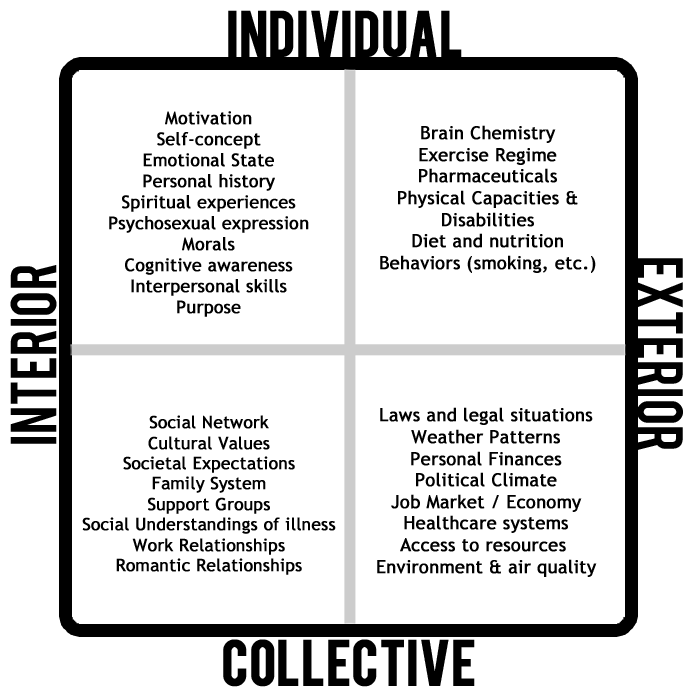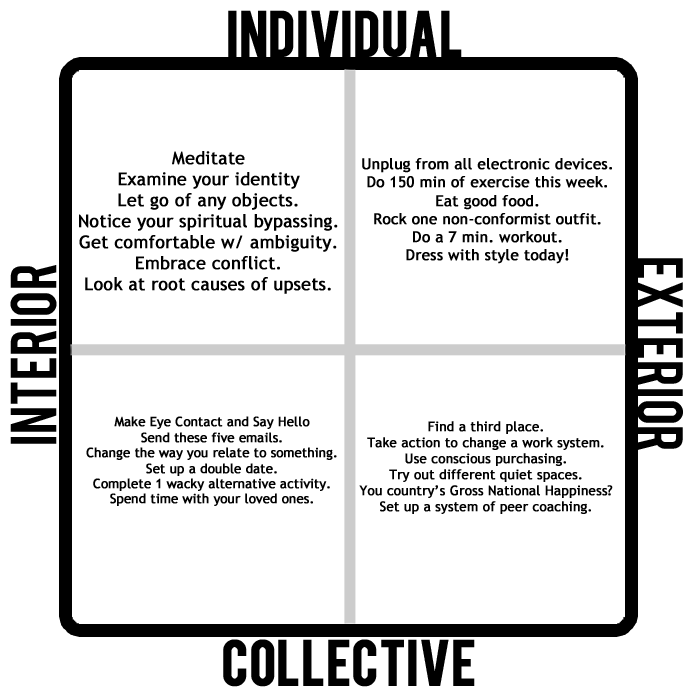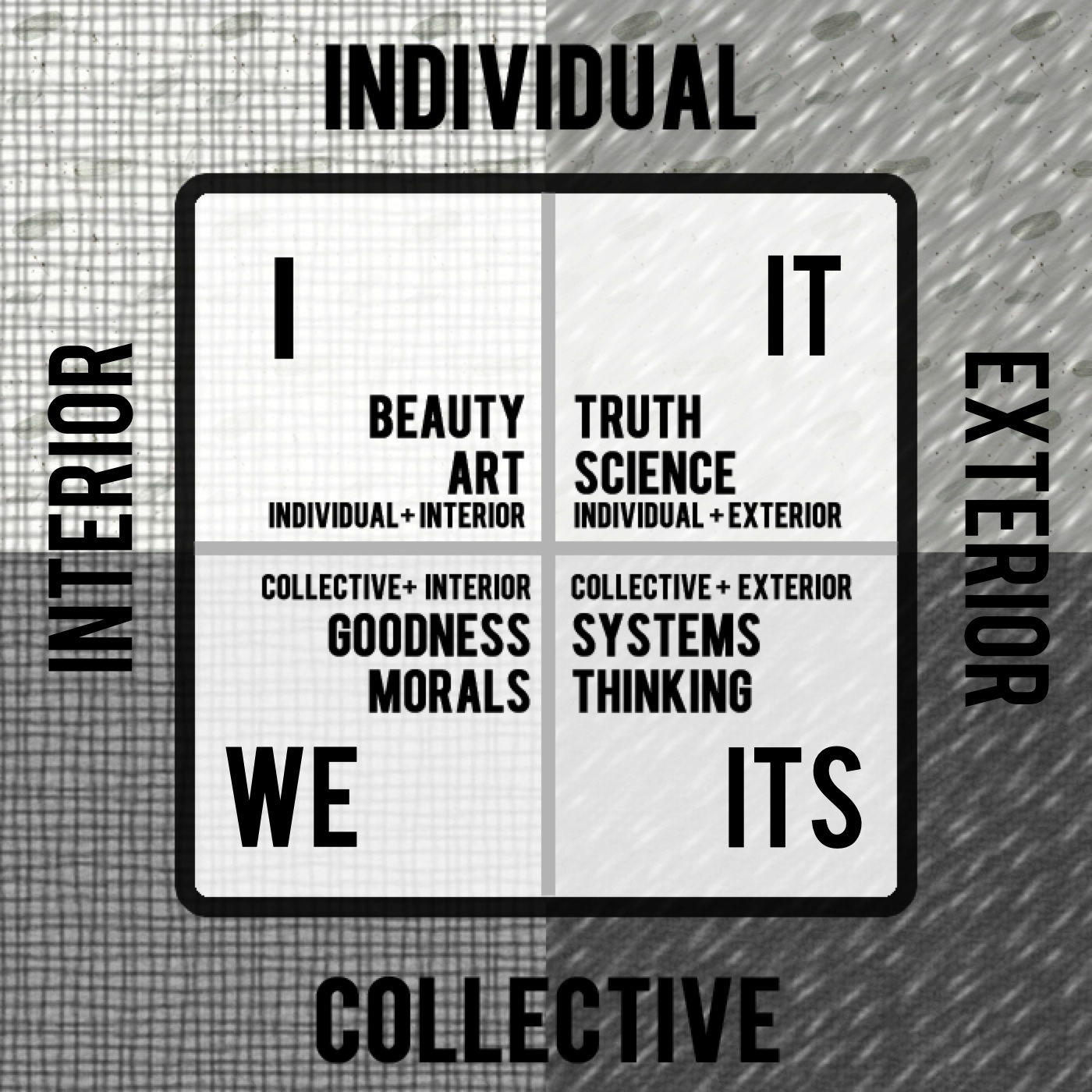Attitude, Behavior, Culture, and Systems
To investigate happiness, let’s look at four fundamental perspectives on reality [1]: the quadrants. Without getting too philosophical, let us look at some causes for happiness (and unhappiness) in all four of these dimensions: we will call them attitude, behavior, culture, and systems. You can call them by different names [2], but they will still be there, coexisting, affecting your life and your happiness.
Attitude:
- Motivation
- Self-concept
- Emotional state
- Personal history
- Spiritual experiences
- Cognitive awareness and abilities
- Interpersonal skills
- Life purpose
Behavior:
- Exercise regime
- Diet and nutrition
- Pharmaceuticals
- Smoking, Drinking, and other substance use
- Brain chemistry
- Bodily health
- Physical capacities & disabilities
Culture:
- Social Network
- Cultural Values
- Societal expectations
- Family system
- Support groups
- Social understandings of illness
- Work relationships
- Romantic relationships
Systems:
- Laws and legal situations
- Weather patterns
- Personal finances
- Political climate
- Job market & economy
- Healthcare systems
- Access to resources
- Environment & air quality

You will notice that ignoring any of the quadrants as a whole will lead to trouble—you will likely find yourself continuously frustrated in your quest for happiness. Focusing on your attitude when your culture is out of whack is like changing your car’s oil when you have a flat tire. Better to do a whole system diagnostic and focus attention on what needs the biggest tune-up.
The Majority of the World Ignores These
Put simply: all four are equally important. They all effect what happens in your life; they all change how you feel. Yet 95% of people around the world flat out ignore one or more of these essential ways of seeing.[3] For example, someone might try to reduce your subjective experience (attitude) to the behavior in your brain, or do the opposite and claim that the behavior of the world around you is a created solely through your attitude.
Accidentally missing a perspective is understandable. It can be a challenge to remember them. But when someone asserts that one—and only one—of these four perspectives is true, they often cause unnecessary pain and suffering.
Also, we use the awareness of these divisions not to separate things out, but to include what we otherwise cannot see. The goal of this particular map is integration, not differentiation.
Putting All of the Pieces Together to Look at Happiness
To illustrate how this sheds light on any given situation, consider the following randomly selected DailyHap happiness suggestions and where they land on a quadrant map. Note which areas you might neglect, and you have found the usefulness of this tool.

Do Not Take My Word For It—Try it for Yourself
Acknowledging this whole picture thinking and applying the quadrants to my own personal challenges has offered massive benefits to me. If you try it, you will start to notice when you are ignoring massively important pieces of truth.
Give it a shot and let us know how it goes. Here is an exercise to get started: Choose one of the following crises and identify causal factors in each quadrant. Then identify solutions in each quadrant.
Personal
- Getting a job
- Earning money and pursuing a passion
- Staying healthy
- Overcoming addiction
- Relieving Stress
- Confronting a boss
- Finding a purpose in life
- The existential dilemma of needing purpose in life but realizing the inherent meaninglessness of being human (we are infinity compared to nothing, nothing compared to infinity)
- Being able to travel to another country
- Investing well
- Scaling a small business rapidly
- Maintaining a long term, healthy partnership, romantic or otherwise
Societal
- Media bias
- Homelessness
- Worldwide economic collapse
- Peak Oil / Energy crisis
- Potable water for every citizen
- Species extinctions
- Rapid climate change
- Multi-drug resistant bacteria
- Nuclear weapons proliferation
- Armed conflict in the Middle East / Africa
- Terrorism
- Poverty
- Population growth
- Universal Education / Improving the current education
- Global Governance
- Improving the US Governance
- Providing basic health care for all humans
[1] For a good introduction to the philosophical underpinnings of the quadrants as both tetra—arising fundamental aspects of reality as well as perspectives through which we (semi) conscious beings can view reality, see the following Introductions to Integral Theory—
There are many names to give to the quadrants. When it comes to improving your life and the world around you, what you call them is less important than being aware that they co-exist and including all the relative truths of their perspectives. Nevertheless the following encompasses some of the common terms:

Individual interior, I, Beauty, Art, Mindset
Individual exterior, It, Truth, Science, Behavior
Collective interior, We, Good, Morals, Culture
Collective exterior, Its, Systems Thinking, Systems
You will notice that all human languages employ the first, second, and third person distinctions. In English these are the “I” (1st person), “We” (2nd person), and “It” (3rd person),[2] which map onto the quadrants perfectly.
[3] It is difficult to determine what percentage of the world is aware of these perspectives, but we can get a general idea of the level of development based on sentence completion tests. Susanne Cook-Greuter’s research showed that less than a combined 6% of USA adults held an Autonomous, Construct-Aware, or Unitive perspective (which would be less than five percent of the total population, including children and teenagers), and it is historically during these stages of development that awareness of these critical perspectives arise. That is how I came up with the 95%.

